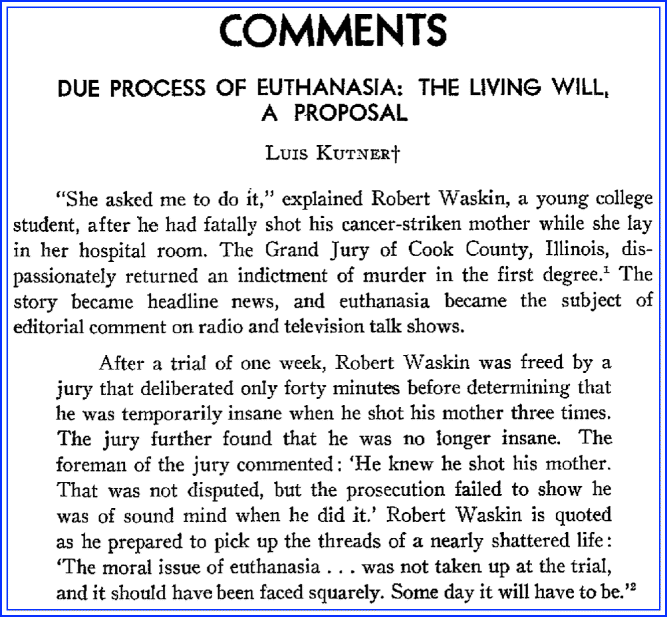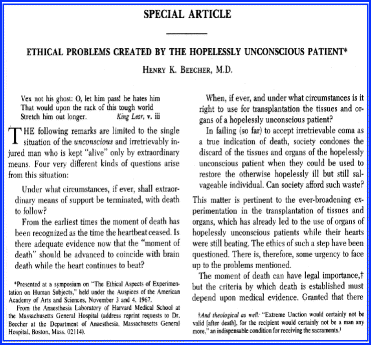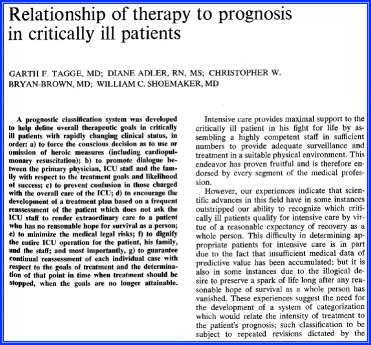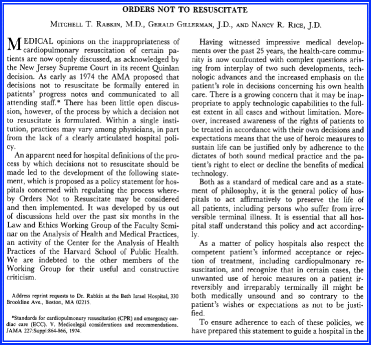(1)
Division of Critical Care Neurology, Mayo Clinic, Rochester, Minnesota, USA
Abstract
This chapter discusses two landmark studies that introduce bioethical questions in the intensive care unit. A historical overview of level of care and self-determination of the patient is discussed.
Short Historical Note 59
Living Will
The Title of the Paper
Kutner L. Due process of euthanasia: the living will, a proposal. Indiana Law J. 1969;44:539–54.

Fig. 8.1
Title page
The Paper and the Times
The benefits of aggressive medical management became of interest in the late 1960s, possibly as a consequence of improved access to more sophisticated care, and the general sense that medicine could provide a cure — at least considerable improvement — to many illnesses. Active discontinuation of life support was grossly interpreted as “euthanasia” and illegal, with the potential for indictment for first-degree murder. Before the 1970s no legal document existed that would inform physicians about what a patient would wanted when catastrophically ill [11].
Planning in advance while competent and not terminally ill would become a major departure from the traditional approach—making decisions when they were needed—and different from who would make them—the patient or the physician. These directives could be used when the time came. It was argued that when individuals become patients, they would be unable to make medical decisions and someone else would have to make the decisions. It would make perfect sense to designate someone who is trusted.
In the United States, these discussions became further intensified after the Cruzan and Quinlan persistent vegetative state cases. The Quinlan case launched the end-of-life movement in the United States.
The Details of the Paper
For the first time, Kutner describes a proposal for what he calls a “living will” (Fig. 8.1). After an introduction describing suicide and euthanasia, aiding and abetting, he proposes solutions for patients to make decisions before they become ill. Kutner called it a living will as a “declaration determining the termination of life,” “a testament permitting death,” “declaration for bodily autonomy,” “declaration for ending treatment,” and “body trust.” The document would provide an individual solution “if bodily state becomes completely vegetated and it is certain that he cannot regain his mental and physical capacities, medical treatment shall cease.” He suggested having the document notarized and attested to by at least two witnesses who would confirm that the person was of “sound mind and acted on his own free will.” The individual’s personal physician or spouse would then keep a copy of the document, with a lawyer or other confidant having an original copy. He also suggested that each individual case should be referred to a hospital committee that would then consider the circumstances under which the document was made. Kutner also felt that at anytime, the individual could revoke the document. Kutner’s principle was that “the patient had the ultimate right to decide what is to be done with him and may not irrevocably confer authority on someone else.” He identified problems with mental illness and felt that if the patient became mentally ill, the court could find him or her incompetent and appoint a guardian. He also specifically pointed out that although the patient is determining the type of medical treatment, the living will is not used as a means to direct the doctor to terminate the patient’s life, and the document does not authorize euthanasia.
Kutner summarized it as follows:
the living will is analogous to a revocable or conditional trust with the patient’s body as the res, the patient as the beneficiary and grantor and the doctor and hospital as the trusties. The doctor is given authority to act as the trustee of the patient’s body by virtue of the patient’s consent to treatment. He is obligated to exercise due care and it subject to liability for negligence. The patient is free at any time to revoke the trust. From another perspective, the patient in giving consent to treatment is limiting the authority the doctor and other medical persons may exercise over his body. The patient has the ultimate right to decide what is to be done with him and may not irrevocably confer authority on somebody else. The patient may not be compelled to undergo treatment contrary to his will. He should not be compelled to take certain drugs, receive inoculations or therapy or undergo surgery without his express assent. At any point he may stop treatment or he may change physicians.
The Message and Acceptance
Over time, the living will became known as an advance directive. Legally, living wills or advance directives fall under the Patient Self Determination Act (PSDA 1990). The act requires hospitals to give patients written notice regarding advance health care directives applicable to the state. The PSDA also includes patient rights: the right to facilitate their own health care decisions, the right to accept or refuse medical treatment, and the right to make an advance health care directive. Facilities must inquire as to whether the patient already has an advance health care directive and make note of this in the patient’s medical records.
Three types of directives are known. First, the living will gives specific direction on health care or appoints an agent or proxy to make decisions on the patient’s behalf in the event of terminal illness [22, 24]. A living will should inform surrogate decision makers of any wishes to withhold or withdraw treatment in situations at the end of life [25, 26, 28].
Second, a durable power of attorney for health care authorizes another person to make decisions on the patient’s behalf even though the patient may not be terminally ill. Third, a mental health declaration provides specific direction or designates a proxy to make decisions about intrusive mental health treatment [5].
Advance directives commonly have statements that would indicate that there is an incurable, irreversible illness, and often, a vegetative state is implied. In the United States, state legislatures passed laws in support of a living will in every state in the Union, but still a low percentage of Americans do complete a living will [1, 9, 29].
The ambiguity of the language used has been a major criticism, as is whether the person who signs the document fully understands the potential implications. Generally, the presence of an advance directive in some way helps physicians and families to understand the patient’s wishes and is a basis for further discussion about the level of care provided [27].
The situation in the United States seems legally settled, although none of it will resolve controversies in bioethics that surface once a while. The situation in countries other than the United States is no less complicated. No living will legislation exists in Italy and Germany. In the United Kingdom, a court order is needed to withdraw nutrition and hydration from the patient.
Short Historical Note 60
Limiting the Level of Care
The Title of the Paper
Tagge GF, Adler D, Bryan-Brown CW, Shoemaker WC. Relationship of therapy to prognosis in critically ill patients. Crit Care Med. 1974;2:61–3.
Rabkin MT, Gillerman G, Rice NR. Orders not to resuscitate. N Engl J Med. 1976;295:364–6.

Fig. 8.2
Beecher’s editorial

Fig. 8.3
Title page
The Paper and the Times
In the late 1950s when patients with acute brain injury could be maintained on a ventilator, discussions emerged that questioned the reality of pushing extraordinary procedures to maintain life. When patients were fully aware of their condition, they could reject further interventions such as hemodialysis or even resuscitation, but the futility discussion here pertained to unconscious patients. Beecher called it the “agonizing death watch” of the family.
Key to Beecher’s article addressing the futility of hopelessly injured patients (Fig. 8.2) was a symposium on ethics on medical progress that addressed the futility of care [4]. Hospital administrators were on the sidelines but understood that costly procedures in hopeless cases could or should be avoided.


Fig. 8.4
Title page
The level of support in intensive care units (ICUs) remained optimal for the vast majority of patients. Patients were admitted to ICUs simply to provide the best care and the best opportunity for survival. Prognostication in ICUs and critical assessment of success of intervention were always on the mind of physicians but rarely put into workable categories.
Very few articles appeared that would question the possibility that for some patients, care in the ICU would be in vain. “Saving lives” and thus “full-court press,” “do everything you can, doctor” were mantras of the 1950s and 1960s. Medicine, and in particular intensive care medicine, was about the best in medical care with the best-trained physicians and the best chance to survive a disorder spiraling out of control. The paper from Mount Sinai School of Medicine in New York addressed these issues. They introduced their paper with the following sentence:
This difficulty in determining appropriate patients for intensive care is in part due to the fact that insufficient medical data of predictive failure has been accumulated; but it is also in some instances due to the illogical desire to preserve spark of life long after any reasonable hope for survival as a whole person has vanished.
Similarly, orders not to resuscitate the patient were virtually nonexistent before 1970, although practices were unknown. Although the 1974 Quinlan case was about withdrawal of care in prolonged unconsciousness, it clearly identified the start of a medical era that would include a do-not-resuscitate (DNR) order as an option. How to go about DNR orders was largely unknown, and both articles clearly spelled out the criteria and circumstances (Fig. 8.3 and Fig. 8.4) when these orders would be appropriate.
Stay updated, free articles. Join our Telegram channel

Full access? Get Clinical Tree








